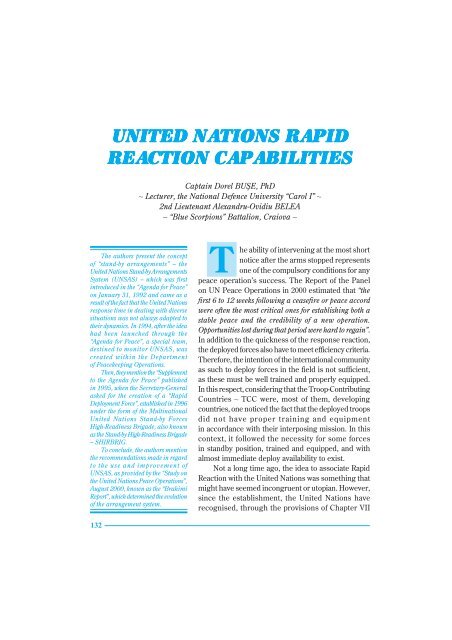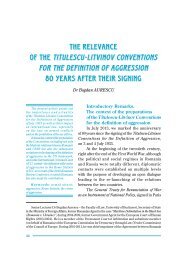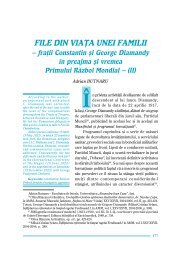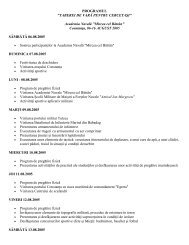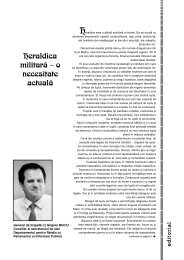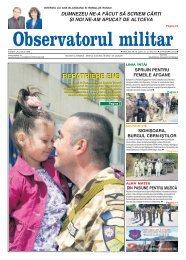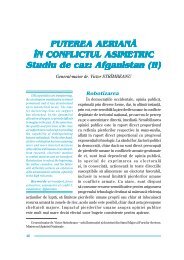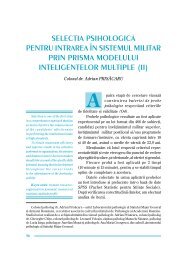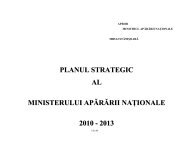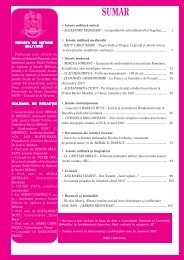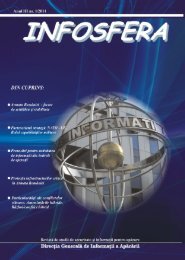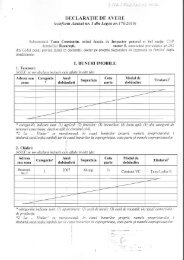Romanian Military Thinking
Romanian Military Thinking
Romanian Military Thinking
You also want an ePaper? Increase the reach of your titles
YUMPU automatically turns print PDFs into web optimized ePapers that Google loves.
UNITED UNITED NATIONS NATIONS RAPID<br />
RAPID<br />
REACTION REACTION CAPABILITIES<br />
CAPABILITIES<br />
Captain Dorel BU{E, PhD<br />
~ Lecturer, the National Defence University “Carol I” ~<br />
2nd Lieutenant Alexandru-Ovidiu BELEA<br />
~ “Blue Scorpions” Battalion, Craiova ~<br />
The authors present the concept<br />
of “stand-by arrangements” – the<br />
United Nations Stand-by Arrangements<br />
System (UNSAS) – which was first<br />
introduced in the “Agenda for Peace”<br />
on January 31, 1992 and came as a<br />
result of the fact that the United Nations<br />
response time in dealing with diverse<br />
situations was not always adapted to<br />
their dynamics. In 1994, after the idea<br />
had been launched through the<br />
“Agenda for Peace”, a special team,<br />
destined to monitor UNSAS, was<br />
created within the Department<br />
of Peacekeeping Operations.<br />
Then, they mention the “Supplement<br />
to the Agenda for Peace” published<br />
in 1995, when the Secretary-General<br />
asked for the creation of a “Rapid<br />
Deployment Force”, established in 1996<br />
under the form of the Multinational<br />
United Nations Stand-by Forces<br />
High-Readiness Brigade, also known<br />
as the Stand-by High-Readiness Brigade<br />
– SHIRBRIG.<br />
To conclude, the authors mention<br />
the recommendations made in regard<br />
to the use and improvement of<br />
UNSAS, as provided by the “Study on<br />
the United Nations Peace Operations”,<br />
August 2000, known as the “Brahimi<br />
Report”, which determined the evolution<br />
of the arrangement system.<br />
132<br />
T<br />
he ability of intervening at the most short<br />
notice after the arms stopped represents<br />
one of the compulsory conditions for any<br />
peace operation’s success. The Report of the Panel<br />
on UN Peace Operations in 2000 estimated that “the<br />
first 6 to 12 weeks following a ceasefire or peace accord<br />
were often the most critical ones for establishing both a<br />
stable peace and the credibility of a new operation.<br />
Opportunities lost during that period were hard to regain”.<br />
In addition to the quickness of the response reaction,<br />
the deployed forces also have to meet efficiency criteria.<br />
Therefore, the intention of the international community<br />
as such to deploy forces in the field is not sufficient,<br />
as these must be well trained and properly equipped.<br />
In this respect, considering that the Troop-Contributing<br />
Countries ~ TCC were, most of them, developing<br />
countries, one noticed the fact that the deployed troops<br />
did not have proper training and equipment<br />
in accordance with their interposing mission. In this<br />
context, it followed the necessity for some forces<br />
in standby position, trained and equipped, and with<br />
almost immediate deploy availability to exist.<br />
Not a long time ago, the idea to associate Rapid<br />
Reaction with the United Nations was something that<br />
might have seemed incongruent or utopian. However,<br />
since the establishment, the United Nations have<br />
recognised, through the provisions of Chapter VII


